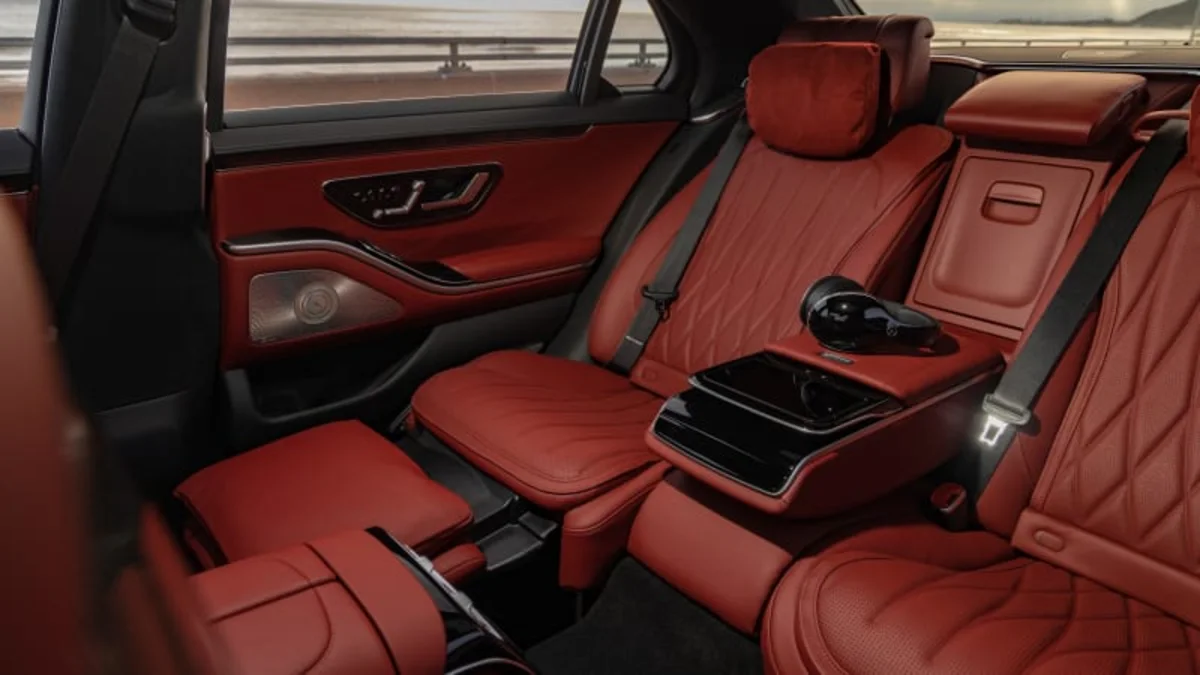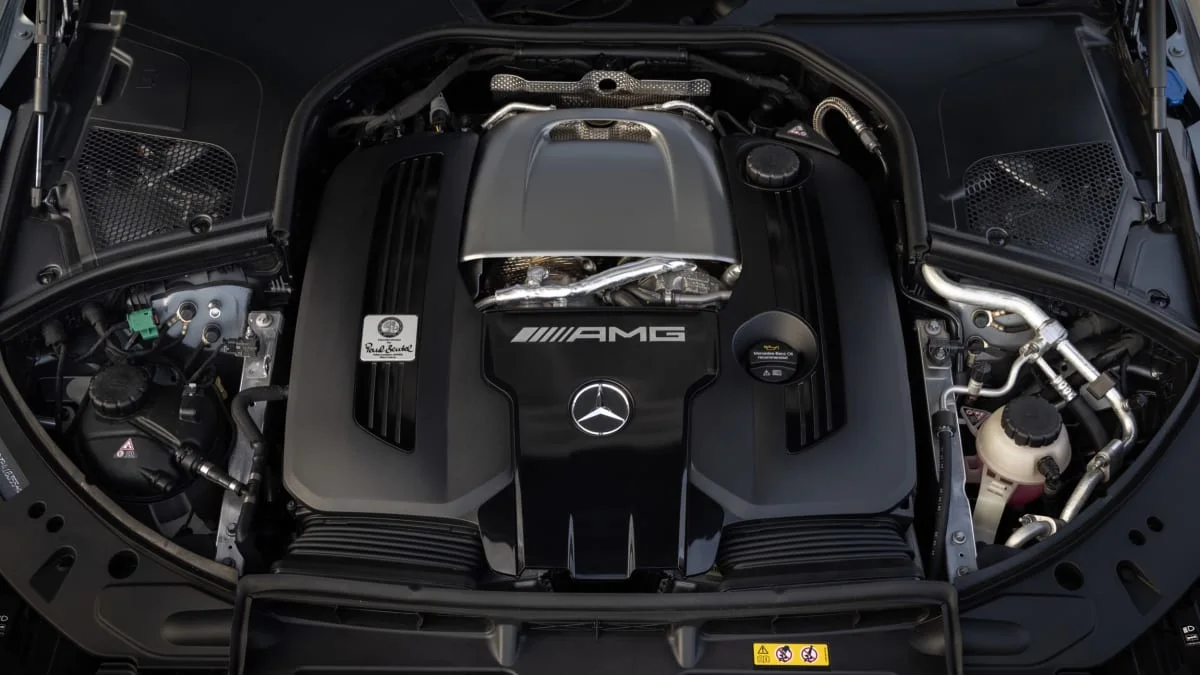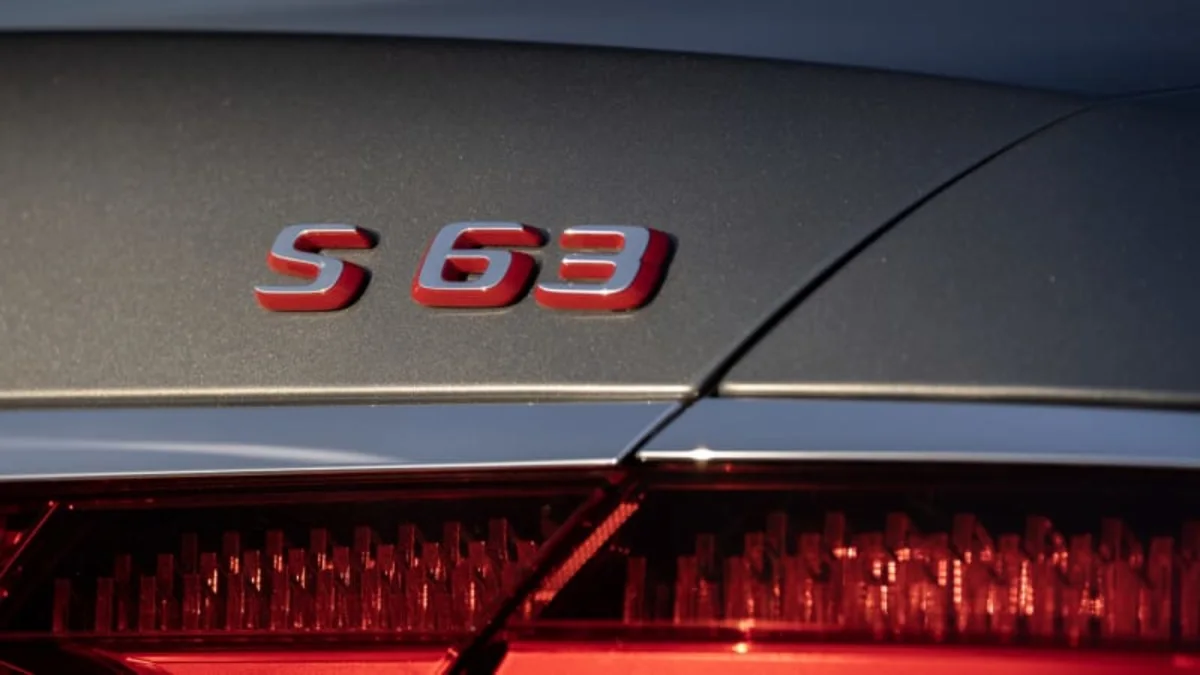SANTA MONICA, Calif. — Although it’s best known as an opulent halo car that features Mercedes-Benz’s latest innovations, the S-Class tends to take on a slightly different sense of purpose after the engineers at Affalterbach get their hands on it. AMG-tuned versions of the full-sized sedan date back as far as the early 1970s with the W116 generation, and the formula has stayed admirably consistent throughout the decades: Stuff a massive power plant in the engine bay and support it with specialized performance hardware for maximum effect. That tradition continues with the new S 63 E Performance, but how that capability is achieved changes in some significant ways.
As the de facto successor to the dearly departed, V12-powered S 65, the S 63 E Performance seeks to further prove there is a replacement for displacement by pairing a boosted V8 with an AMG-developed hybrid system. Together, the powertrain develops a peak 791 horsepower and 1,055 pound-feet of torque, figures which make this the most powerful sedan in Mercedes-AMG’s history. It also allows the S 63 E Performance to be motivated purely by electricity for approximately 20 miles on a charge (its 13.1-kilowatt-hour battery pack was designed for performance rather than range, AMG notes), a feature that is expected to become an increasing necessity in European city centers over the coming years.
While this approach addresses the concerns of enthusiasts and regulators, it results in a powertrain that’s stunningly complex and a car that tips the scales at over 5,800 pounds – or about 900 pounds more than its predecessor. That’s not a negligible amount of mass, but the S 63 E Performance is also packing some clever engineering to address it.
Before diving into the mechanical nitty-gritty, let’s take a moment to soak in the S 63 E Performance’s aesthetic. It’s not a wild departure from a standard S-Class, but elements like the AMG-specific grille, front fascia, side skirts, rear diffuser and quad-tipped exhaust deliver a sportier appearance while keeping things relatively low-key. It’s a similar story inside, where aside from the flat-bottomed AMG steering wheel, badging and S 63-specific trim elements, it’s largely business as usual. That also means there’s still a distinct emphasis on providing a luxurious experience to the passengers in the back seats, as S-Class owners are far more likely to be chauffeured around in their cars than those who are cross-shopping E 63s and M5s.


Up front, the 12.8-inch OLED touchscreen infotainment system offers up real-time information about the hybrid system’s state of charge, electric motor temperature and battery temperature, along with readouts that provide a visual representation of the power flow of the entire drive system. The digital gauge cluster and head-up display can be customized with AMG-specific layouts for a more sport-oriented look, too.
The big news, though, is that powertrain. There’s a lot going on here, so we’ll start with the internal combustion stuff. Under the hood is AMG’s familiar 4.0-liter, twin-turbocharged V8 that develops 603 horsepower on its own, and it’s matched up with a nine-speed automatic gearbox that sends power to all four wheels through a variable all-wheel-drive system.
Situated behind the transmission is a permanently excited synchronous electric motor that offers 188 horsepower for up to 10 seconds at a time, or 94 hp continuously. It also generates 236 lb-ft of torque — all that power allows the S 63 E Performance to operate at speeds of up to 87 mph purely on electricity. The hybrid system has its own two-speed transmission as well as an electronically controlled limited-slip differential. The electric motor can control drive torque to each wheel independently through the limited-slip differential, effectively creating a supplemental, hybrid-system-based electronic stability control system. According to Mercedes, this means the combustion engine doesn’t have to be throttled, allowing it to operate at higher torque, ultimately increasing the car’s agility.
AMG says that the S 63 E Performance’s 13.1-kWh rear-mounted battery pack takes engineering inspiration from the system used in Mercedes-AMG Petronas F1 team’s hybrid race cars – a design which emphasizes repeatable performance that can be called upon in rapid succession. To achieve that in the S 63, non-conductive liquid coolant is pumped through the pack and directed around each of its 1,200 cells to ensure that the heat is distributed evenly throughout and optimum temperatures are maintained. Four different levels of recuperation strength can be called up by pressing the drive mode button on the steering wheel (rather than turning it like a dial to change drive modes), and they range from Level 0’s virtually resistance-free coasting to Level 4, which is aggressive enough to allow for one-pedal driving.

To ensure that the S 63 E Performance’s chassis can keep up with the powertrain, AMG outfitted it with a specially tuned air suspension and adaptive dampers as well as two-piece electromechanical anti-roll bars that can connect and disconnect as needed for more body control or improved ride quality. Standard rear-axle steering also allows the rear wheels up to 2.5 degrees of steering angle, which is less than what the non-AMG S-Class offers, but it’s better than nothing. At speeds below 62 mph, the rear wheels turn in the opposite direction of the front wheels, effectively shortening the car’s wheelbase, while at higher speeds the rear wheels turn in phase with the fronts to improve stability.
Pressing the start/stop button brings the S 63 E Performance to life exclusively under electric power. Comfort mode – one of the seven drive modes available – is the default, and it incorporates the V8 into the mix as needed. Electric mode, meanwhile, does its best to keep the car motivated purely by electricity, but if you dig deep enough into the throttle, it will automatically switch over to Comfort mode and fire up the engine.
Settled in at the helm, the supple bolstering of the front seats – which are virtually identical to the thrones in the standard S-Class aside from their lack of headrest pillows – make it clear that the S 63 E Performance’s mission is more about fast grand touring and unhurried cruising rather than corner carving.
And it certainly delivers in that regard. While heading through Santa Monica and up Pacific Coast Highway, the S 63 E Performance delivered vault-like serenity in Comfort mode. Although the short, relatively stiff sidewalls of the Michelin Pilot Sport 4S performance tires occasionally allow a particularly egregious road imperfection to get through, the air suspension and adaptive dampers do a remarkable job of smoothing things out otherwise, even in the stiffened Sport and Sport+ modes.
Stretches of open road up in Malibu gave us a chance to get to know those more aggressive modes a bit better, too. While it occasionally generated an ungainly clunk (something we’ll chalk up to the rough edges of a pre-production model), immediate throttle response is an obvious and immediate benefit of hybrid system, as it eliminates any semblance of turbo lag from the V8. We were slightly underwhelmed by the S 63’s straight-line performance, though. While a 0-60 mph sprint in 3.3 seconds is undeniably quick by performance car standards, it’s less impressive when you consider the colossal amount of grunt that this car has to work with. In practice, it only feels marginally quicker than the approximately 700-pounds-lighter Audi S8, one of the S 63’s few competitors, despite having a massive advantage in both horsepower and torque. Whether that’s a product of the powertrain’s limitations or is mass-related (most likely) is difficult to ascertain during a street drive like this, but that quadruple-digit torque doesn’t guarantee that you’re going to be the king of stoplight drags.



The tight, winding roads of the Malibu hills aren’t necessarily this car’s natural environment either, but the rear-axle steering makes the sedan surprisingly agile, while the optional carbon ceramic brakes delivers excellent stopping power without over-eager response at lower speeds. You’re always aware of the S 63’s substantial footprint while guiding it through switchbacks, but it does an excellent job of mimicking the behaviors of smaller AMG-tuned sedans, and it’s even willing to do a bit of tail wagging out of slower corners if you ask for it.
Like the S8, the S 63 E Performance is a bit of an anomaly from a conceptual standpoint. If you’re buying an S-Class to be driven around in, does peak performance really even matter? And if you’re buying it because of the performance, why are you considering a sport sedan that’s outclassed in virtually every metric by the smaller, lighter and less expensive Mercedes-AMG E 63 S?
Perhaps some things don’t have to make logical sense. Judged in a vacuum, the S 63 E Performance is a feat of engineering that also happens to be legitimately opulent and highly capable. The end result isn’t quite the jaw-dropping Q-ship that the numbers may have suggested, but the seat massagers and Burmester audio system should prove to be effective coping mechanisms for would-be owners.
Read the full article here


